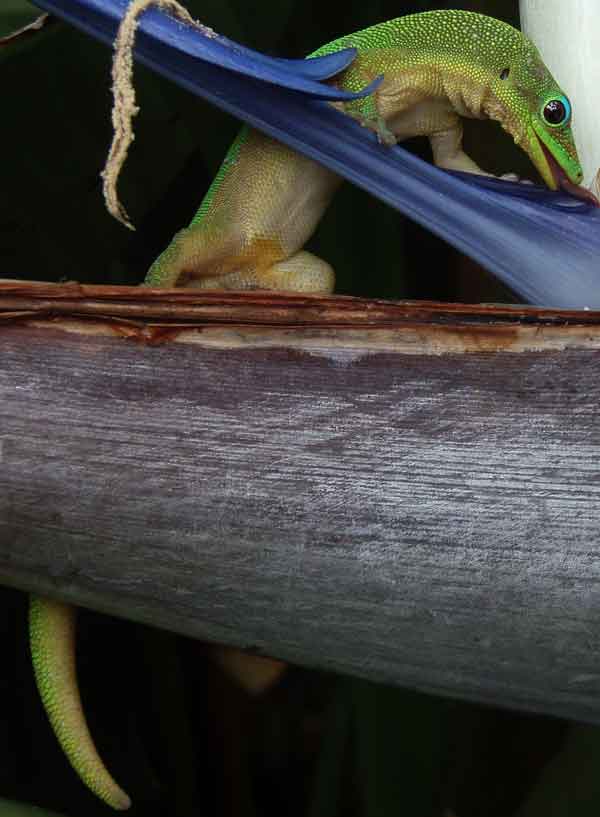
Phelsuma laticauda (*)
Superregnum: Eukaryota
Regnum: Animalia
Subregnum: Eumetazoa
Cladus: Bilateria
Cladus: Nephrozoa
Superphylum: Deuterostomia
Phylum: Chordata
Subphylum: Vertebrata
Infraphylum: Gnathostomata
Megaclassis: Osteichthyes
Superclassis: Sarcopterygii
Superclassis: Tetrapoda
Cladus: Reptiliomorpha
Cladus: Amniota
Classis: Reptilia
Cladus: Eureptilia
Cladus: Romeriida
Subclassis: Diapsida
Cladus: Sauria
Infraclassis: Lepidosauromorpha
Superordo: Lepidosauria
Ordo: Squamata
Subordo: Gekkota
Infraordo: Gekkomorpha
Superfamilia: Gekkonoidea
Familia: Gekkonidae
Genus: Phelsuma
Species: Phelsuma laticauda
Name
Phelsuma laticauda (Boettger, 1880)
Synonyms
Pachydactylus laticauda Boettger, 1880
References
Phelsuma laticauda at the New Reptile Database
Vernacular names
Deutsch: Goldstaub-Taggecko
English: Gold dust day gecko, Broad-tailed day gecko
The gold dust day gecko (Phelsuma laticauda) is a diurnal species of gecko. It lives in northern Madagascar, and on the island of Comoros; it has also been introduced to Hawaii and other Pacific islands.[1] It's typically seen in houses and various trees. The gold dust day gecko feeds on insects and nectar. It is commonly known as the mascot of GEICO Insurance, and also the main character of the video game series, Gex.
One subspecies is recognized (in addition to the nominate one): Phelsuma laticauda angularis.[2]
Description
This lizard can reach a total length of 3.9-5.1″ (10-13cm).[3] The body colour is a bright green or yellowish green or rarely blue. Typical for this day gecko are the red speckles on the neck and the upper back. There are three rust-coloured transverse bars on the snout and head; the upper part of the skin around the eye is blue. On the lower back there are three tapering red bars. The tail is slightly flattened. The under side is off-white. Juveniles lack the red colourations and the tail and limbs appear off-white.
Diet
Phelsuma laticauda laticauda licking nectar from the 'bird of paradise' flower of Strelitzia
Close-up of gold dust day gecko on the island of Hawaii
These day geckos feed on various insects and other invertebrates, and are also capable of eating other smaller lizards. They also eat soft, sweet fruit and pollen and nectar from flowers, often congregating in groups of many individuals to feed off of one plant.
Behavior
Gold dust day geckos fighting on a banana plant in central Saint-Denis, Réunion
The males of this species are rather aggressive. They do not accept other males in their territory. In captivity, where the females cannot escape, the males may also seriously wound a female.
Reproduction
The females lay up to 10 eggs. At a temperature of 28 °C, the young will hatch after approximately 40–45 days. The juveniles measure 55–60 mm. They should be kept separately since the juveniles can be quite quarrelsome. Sexual maturity is reached after 10–12 months.
Captivity
This gecko is occasionally kept as a pet; with good care, this species may live up to 15 years.[3]
References
Gerlach, J.; Ineich, I. & Vences, M. (2011). "Phelsuma laticauda". The IUCN Red List of Threatened Species. IUCN. 2011: e.T61433A12483895. doi:10.2305/IUCN.UK.2011-2.RLTS.T61433A12483895.en. Retrieved 26 December 2017.
Phelsuma laticauda at the Reptarium.cz Reptile Database. Accessed 6 June 2013.
Healey, Mariah. "Gold Dust Day Gecko Care Sheet". ReptiFiles. Retrieved 2022-01-18.
Christenson, Leann and Greg (2003). Day Geckos In Captivity. Ada, Oklahoma: Living Art Publishing. p. 194. ISBN 0-9638130-2-1.
Henkel, F.-W.; Schmidt, W. (1995). Amphibien und Reptilien Madagaskars, der Maskarenen, Seychellen und Komoren. Stuttgart: Ulmer. ISBN 3-8001-7323-9.
McKeown, Sean (1993). The general care and maintenance of day geckos. Lakeside, CA: Advanced Vivarium Systems.
Retrieved from "http://en.wikipedia.org/"
All text is available under the terms of the GNU Free Documentation License

